21 Creepy Abandoned Military Sites From Around the World
- Get link
- X
- Other Apps
21 Creepy Abandoned Military Sites From Around the World
Remnants of WWII and the Cold War still remain.

SERGIY ROMANYUKGETTY IMAGES
These sites were once training grounds, airfields, and state-of-the-art reconnaissance installations. Now, they're abandoned.
ADVERTISEMENT - CONTINUE READING BELOW
1 of 30
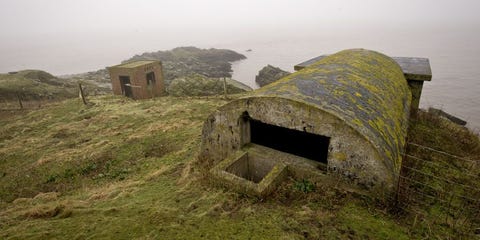
BEN BIRCHALL - PA IMAGESGETTY IMAGES
Palmerston Forts
A series of island forts off the coast of Britain were built during Victorian times to offer resistance to a French invasion. Later these forts were designed to serve as defense stations during World War I, thought to serve as a line of protection against submarine threats. Following the war, many of the sites transformed into resorts, some still operating and one — No Man’s Land — abandoned after disease emerged on the island.
ADVERTISEMENT - CONTINUE READING BELOW
2 of 30

MICHAELGSEDLAKGETTY IMAGES
Ghost Fleet
Off the coast of San Francisco, in Suisun Bay, an abandoned fleet of up to 100 war ships once floated interlinked on the water. This Ghost Fleet held strong at 50 abandoned ships from the United States’ National Defense Rescue Fleet for many years until the environmental hazards of decaying ships and chipping paint led the one-by-one removal of the ships to museums and junkyards. Think of this site as a twice-abandoned military establishment.
ADVERTISEMENT - CONTINUE READING BELOW
3 of 30
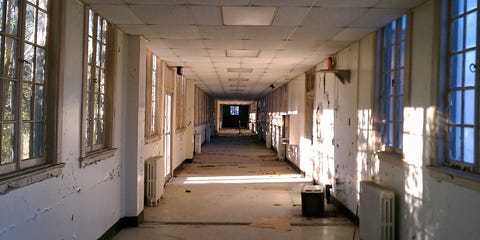
SLWORKING2FLICKR
Charleston Naval Shipyard
Opened as a drydock in 1901, the Charleston Naval Shipyard contributed to multiple U.S. wars, including serving a key role during World War II, as a home for ship repair and construction.
The site was eventually closed in 1995 and parts of the property have undergone redevelopment though portions of the historic site remain standing.
4 of 30

BOSTON GLOBEGETTY IMAGES
Fort Terry
Built in 1898 on Plum Island off the coast of New York, Fort Terry was used as defense during the Spanish-American War. The site was also active during both world wars. Once the protection was deemed unnecessary, the fort, in 1969, transformed into the Plum Island Animal Disease Center.
ADVERTISEMENT - CONTINUE READING BELOW
5 of 30

SASA STOJANOVIC SAPAGETTY IMAGES
Zeljava Underground Air Base
Deep beneath Croatian soil lies the Zeljava Underground Air Base used in both world wars. It housed fighter jets and was designed to withstand a direct hit from a 20-kiloton nuclear bomb. The $6 billion spent on its construction made it one of Europe’s largest and most expensive military projects.
With runways above ground, the site was destroyed during the Yugoslav Wars in the 1980s, with explosions wrecking the bulk of the underground base. Local authorities still use the site for live training exercises due to the extent of mines located in the area.
ADVERTISEMENT - CONTINUE READING BELOW
6 of 30

AUTHOR KECKOWIKIMEDIA COMMONS
Swiss Military Bunkers
The Swiss military bunkers, located in the Alps in Switzerland, offer a textbook definition of camouflage. Even in a so-called neutral country, Switzerland was ready for plenty in the way of military attacks, created a vast network of secret bunkers, located within rocks, barns, or hillsides. Most have been long abandoned.
7 of 30
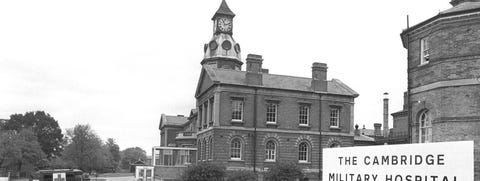
PA IMAGESGETTY IMAGES
Cambridge Military Hospital
The first base hospital, the Cambridge Military Hospital, opened in July 1879 in Hampshire, England, welcoming soldiers directly from the Western front during wartime. As the birthplace of plastic surgery, the hospital served multiple functions for a century, eventually closing in the 1990s due to the costs of operating an aging building, although recent reports have developers hoping to turn portions of the building into housing.
ADVERTISEMENT - CONTINUE READING BELOW
8 of 30

ULLSTEIN BILDGETTY IMAGES
Wunsdorf Soviet Camp
The Wundsdorf Soviet Camp, the largest Soviet headquarters outside of Russia, stood shrouded in mystery in Hauptallee, Germany, 25 miles outside of Berlin.
For decades before the fall of the Berlin Wall, the site housed 75,000 men, women and children. When the wall crashed, the site was abandoned, leaving behind 100,000 rounds of ammunition and countless pieces of trash, furniture, and home supplies.
ADVERTISEMENT - CONTINUE READING BELOW
9 of 30

SERGIY ROMANYUKGETTY IMAGES
The Russian Woodpecker
While some military bases descend underground, one massive antenna, nicknamed the Russian Woodpecker, rises 50 stories high positioned in the wilderness of Russia.
Before it was abandoned, it was apart of the Soviet’s powerful radar system used during the Cold War. It remains a landmark for tourists.
10 of 30

MAK_PHOTOGETTY IMAGES
Cape May Bunker
Built on the sand off the coast of Cape May in New Jersey, the Cape May Bunker served as a gun placement to protect America’s East Coast. It was constructed at the beginning of World War II when military leaders believed that war would come to American shores. The site is now part of a state park.
ADVERTISEMENT - CONTINUE READING BELOW
11 of 30

BARRY PETERSWIKIMEDIA COMMONS
German Submarine U-352
On the Atlantic Ocean floor, a rusty submarine holds a historic past. Constructed in 1942, this U-352 submarine was a part of the “Wolfpack” for the Nazis during the Battle of the Atlantic. The submarine sank to the bottom during combat and now offers a popular scuba diving destination.
12 of 30
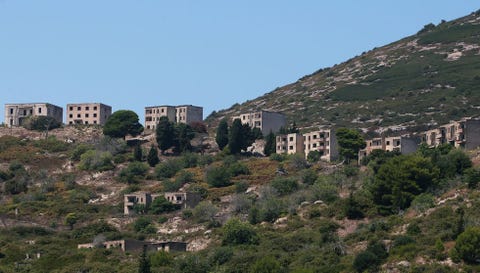
GENT SHKULLAKUGETTY IMAGES
Sazan Island Base
Several abandoned or still-thriving military bases exist on islands, but the Sazan Island Base offers an intricate connection of underground tunnels once used by the Soviets as a weapon plant. Italy first used the island, which later became a hub for military action during the Cold War.
Albania’s government now operates the island, used for everything from tourism to detecting pirate and smuggling activity.
ADVERTISEMENT - CONTINUE READING BELOW
13 of 30
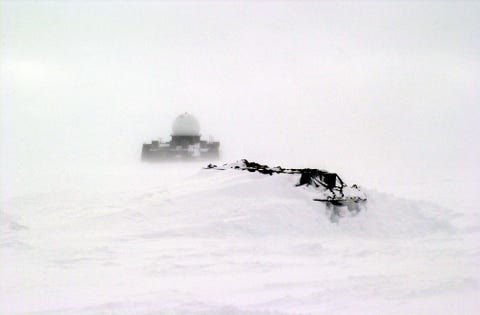
CATHERINE CROUCH / USAFWIKIMEDIA COMMONS
The Inuvik Dome
Throughout the Cold War, the whole world watched expectantly. Even the Artic was involved; it employed a system called Distant Early Warning (DEW) meant to detect incoming bombs launched toward North America.
After the Cold War, the governments of the United States, Canada, Greenland (pictured), and Iceland ceased operations of the system and the dome-shaped structures were abandoned or dismantled.
ADVERTISEMENT - CONTINUE READING BELOW
14 of 30

RANDY WELLSGETTY IMAGES
Fort Jefferson
In the Florida Keys, an island fortress, called Fort Jefferson, was constructed in 1846 to help fight against piracy in the Caribbean Sea. A lofty, six-sided brick wall surrounded living quarters where soldiers and equipment were stored.
After the dispute calmed, Fort Jefferson turned into a Civil War prison. Now it serves as a national monument visited by tourists.
15 of 30

KARENFOLEYPHOTOGRAPHYGETTY IMAGES
Bannerman Castle
In the early 1900s, Frank Bannerman built a castle on an island in the Hudson River, 50 miles from New York City. The never-finished castle turned into a storage facility for his weapons surplus business.
While not technically a true military site, the ammunitions held on the site consisted of a vast array of military weapons, including historic relics belonging to George Washington. Explosions and fires have mired the site for 100 years and the decrepit old shell of the castle remains owned by the state of New York.
ADVERTISEMENT - CONTINUE READING BELOW
16 of 30
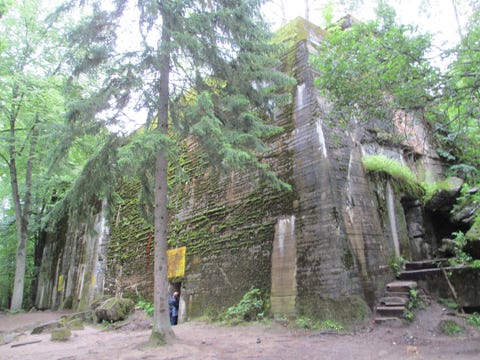
AVI1111 DR. AVISHAI TEICHERWIKIMEDIA COMMONS
Wolf’s Lair
Hitler resided in several bunkers during World War II, but none more popular than Wolf’s Lair in Poland. This steel-reinforced concrete structure was Hitler’s home for over 800 days of the war and was where he made decisions such as the construction of death camps.
He survived an assassination attempt in the bunker and following the Germany defeat much of the bunker was destroyed. Portions remain, now covered in moss and deserted, but still a growing tourist attraction.
ADVERTISEMENT - CONTINUE READING BELOW
17 of 30
Nekoma
Designed as a pyramid for an unknown reason, the Mickelsen Safeguard Complex near Nekoma, N.D., was a radar system intended to find and destroy missiles launched at the U.S. Inside the complex, along with radar, were 30 Spartan antiballistic missiles and 16 Sprint missiles.
Because of a treaty with the Soviet Union that limited the number of weapons complexes each country could have, Mickelsen didn't even stay in service for an entire year. The complex was deactivated on Feb. 10, 1976.
18 of 30
Titan I Missile Complex
You won't find much to see when scanning a 57-acre parcel in rural Eastern Washington, but dive 155 feet below the ground and you'd find three 1960s-built silos that once housed nuclear-tipped Titan I rockets. These concrete and steel facilities with 14-foot-thick walls boast a mix of tunnels and oddly arranged underground rooms. Some were updated to host Titan II rockets, but all were eventually decommissioned as the military continued to modernize (though airmen continue to man remote silos containing Minuteman III ICBMs). These facilities were self-sufficient, including having their own water-treatment facilities, food, and fresh air supplies.
ADVERTISEMENT - CONTINUE READING BELOW
19 of 30
Fort Ord
Located on California's central coast off Highway 1, Fort Ord represents one of the most picturesque abandoned sites in North America. The fort, located 80 miles south of San Francisco, was used primarily as a training center for U.S. Army infantry, seen by the Olympic-size swimming pool that has attracted many a photographer and the rows of barracks overgrown by the natural beauty of the area. It was also well-known for 21 stables designed to house warhorses and mules. Fort Ord was established in 1917, underwent improvements in the 1930s, and stayed open until 1994 when it was closed as part of military downsizing.
ADVERTISEMENT - CONTINUE READING BELOW
20 of 30
Fort Tilden
When it was established in 1917, this fort in Queens pointed its cannons toward the sea to protect New York. During World War II, Fort Tilden beefed up security "and concrete" in case of an attack. But the Fort wasn't needed during the war, was decommissioned in 1974, and has since become part of the National Park Service and the site of urban exploration.
21 of 30
Johnston Atoll
Now a National Wildlife Refuge deep in the Pacific, Johnston Atoll hasn't always been about the birds. The atoll, which makes up 696 acres of land over 800,000 square miles of ocean, was made a bird refuge in 1926. The largest of the four islands "Johnston Island" became the site of a U.S. Navy runway in 1934. The site turned toward nuclear testing from 1958 to 1975, complete with test launches and radioactive debris. Then, in 2003, Johnston Atoll was given back to the birds, though 1300 people still live and work there.
Follow me on Instagram and twitter at pepperitto737
- Get link
- X
- Other Apps

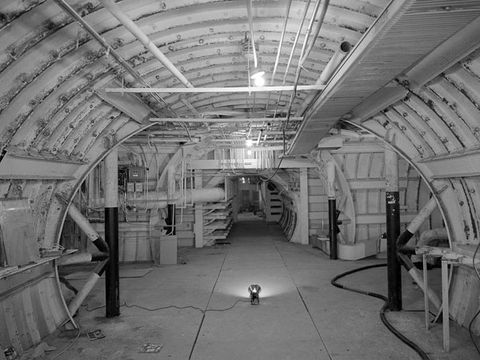




Comments
Post a Comment